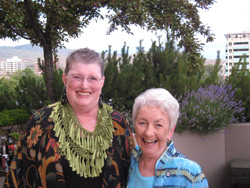You are here
 During the time I have been chair of our association, I have had the opportunity to visit many chapters and to talk to hundreds of members. I also have had the chance to see the ways the Psychiatric Rehabilitation Association (PRA) can grow as we modernize and globalize our presence in the mental health field, with a new name and brand. One of the most exciting aspects of repositioning our brand is the opportunity we have to develop international partnerships with mental health systems, providers, researchers, educators, and individuals in recovery. No two individuals embody this mission more than Carolyn Peterson and Mary Huggins, former board members, Beard Award winners, CPRPs, as well as many other distinctions. For decades, Mary and Carolyn have played numerous roles in the growth of our association. For those of you who attend the PRA Annual Conference regularly, they are a consistent presence and recognized as the “dynamic duo.” I have known them since I attended my first conference in New Orleans in 1993, and have had many fabulous evenings at the International Committee reception with them. As PRA’s board chair, I am inspired by the decades of service and commitment they have given to our association; I can only hope to achieve such longevity. They continue to lead efforts to expand relationships and the CPRP designation throughout the world with tenacity and resolve. Recently, I had a chance to catch up with these two PRA Dincin Fellows and talk about some of their experiences. For those of you who are not familiar with Carolyn and Mary, consider this your introduction.
During the time I have been chair of our association, I have had the opportunity to visit many chapters and to talk to hundreds of members. I also have had the chance to see the ways the Psychiatric Rehabilitation Association (PRA) can grow as we modernize and globalize our presence in the mental health field, with a new name and brand. One of the most exciting aspects of repositioning our brand is the opportunity we have to develop international partnerships with mental health systems, providers, researchers, educators, and individuals in recovery. No two individuals embody this mission more than Carolyn Peterson and Mary Huggins, former board members, Beard Award winners, CPRPs, as well as many other distinctions. For decades, Mary and Carolyn have played numerous roles in the growth of our association. For those of you who attend the PRA Annual Conference regularly, they are a consistent presence and recognized as the “dynamic duo.” I have known them since I attended my first conference in New Orleans in 1993, and have had many fabulous evenings at the International Committee reception with them. As PRA’s board chair, I am inspired by the decades of service and commitment they have given to our association; I can only hope to achieve such longevity. They continue to lead efforts to expand relationships and the CPRP designation throughout the world with tenacity and resolve. Recently, I had a chance to catch up with these two PRA Dincin Fellows and talk about some of their experiences. For those of you who are not familiar with Carolyn and Mary, consider this your introduction.
Q: What have been some of the most rewarding aspects of your careers?
Both Carolyn and Mary felt that developing and joining PRA was the beginning of their journey in the psychiatric rehabilitation (PSR) field. In the earliest days of PSR, PRA created a community where people with new ideas were developing new services and programs. PRA not only resulted in better services for individuals in recovery, but service providers and programs also became less isolated. Both Mary and Carolyn have seen the development of diverse new PSR programs throughout their careers. For Carolyn, one of the newly developed CSP programs led her to PRA where she found her niche and providers with the same ideas and values, who also spoke the same language. She found colleagues and people to run ideas by.
Q: What are some of the biggest challenges you have encountered? How did you overcome them?
This question was tough for women with more than 50 years of service in PSR. One issue raised by Mary was the constant and significant role that our association has played in addressing stigma. Most recently, much of the social and handgun violence communities have experienced brings stigma back to the forefront of public and political discussions. Both Carolyn and Mary are invested in how we can respond to how communities react to violence of this nature, and consistently seek to address and reduce stigma.
Other areas where both Mary and Carolyn have seen advancement is in developing and supporting the workforce. Carolyn noted that PRA is a welcoming association comprised of diverse leaders and professionals and that PRA needs to continue to focus on mentoring new people and develop leaders in PSR. PRA is able to bring people together in chapters and offer them experience and partnership. This leads, as Carolyn noted, to an “infusion of new ideas and we need that in the field.” This is an essential ingredient and the time is now to catch new professionals and engage with them. Both Mary and Carolyn also strongly believe in rowing service programs, diversifying how they are paid for, and examining the minimum qualifications of the workforce. She added, “Recovery is still not a given and that’s still shocking. We still have a lot of work to do there.”
Both Mary and Carolyn are hopeful that PRA can continue to support and strengthen its mission to affect change in overall attitudes about recovery, services, and that for PRA, things are changing for the better; confidence in association is growing back. As Mary noted, “Now more than ever, the CPRP has helped us find our identity as an association. The process is harder and people have to earn it/work for it. It’s the biggest contribution – and to world.” And clearly, Carolyn and Mary’s focus and work are not only limited to the United States and Canada. For decades, Mary and Carolyn have been the forces behind the International Committee, hosting receptions and events for providers and people in recovery from numerous locations, including, but not limited to, Singapore, Australia, New Zealand, Italy, Nigeria, Japan, Sweden, the Arab Emirates, and Israel.
Q: How did obtaining your CPRP designation help you help more people throughout your career?
The most notable reply from Mary and Carolyn was how the CPRP helped growth beyond just original workforce training. Carolyn commented, “The credential represents a new avenue for expertise and provided a foundation – a better definition – of what the services are for most practitioners. In many ways, the CPRP was different to get than other credentials because it moves beyond the academic aspects of mental health and details the work and the practice of what PSR is and what providers do. It’s where you ‘hang your hat’ and defines us as a field.” Mary agreed, “The CPRP defines us – it is accepted and an understood niche. CPRP providers have a sense of who they are and what they bring to recovery.”
Q: What was one of the most meaningful experiences you had with PRA?
For both women, unquestionably it has been the development of new education and training programs. Carolyn and Mary talked about how, from the beginning, the PRA Annual Conference has always been a focal and important part of the association, and the conference has always been on the cutting edge for educational activities and provided world-class training for the PSR workforce. Even from the early days of pre-conference institutes and workshops, you would meet new, fresh people every year with new information and ideas. As Mary noted, “People have genuine enthusiasm for PSR. Part of being at [the PRA Annual Conference] was that experience.” This was one of the many reasons they decided to spearhead the development of the International Committee, combined with the growing number of new people attending from other and new countries. Carolyn agreed, “The International Committee has been grounding for them – always something new and exciting with other countries to expand PSR and learn from experts in research and services.”
Q: Do you have any advice you would offer professionals about how to make the most out of their careers?
Join PRA. Period. (Author’s note: No, really. That’s what they said.)
Mary joked that while not trying to be biased: “If you’re not in PRA, why are you in the field at all?” Carolyn agreed. “We provide a community within a larger health care environment that is welcoming and that promotes recovery. Our association always has.”
Q: Where is PRA 10 years?
Mary: “In 10 more years every state has adopted the CPRP and is funding PSR at the level necessary.”
Carolyn: “Active chapter in every state. Maybe even world domination.”
Mary: “Well, that goes without saying.”



